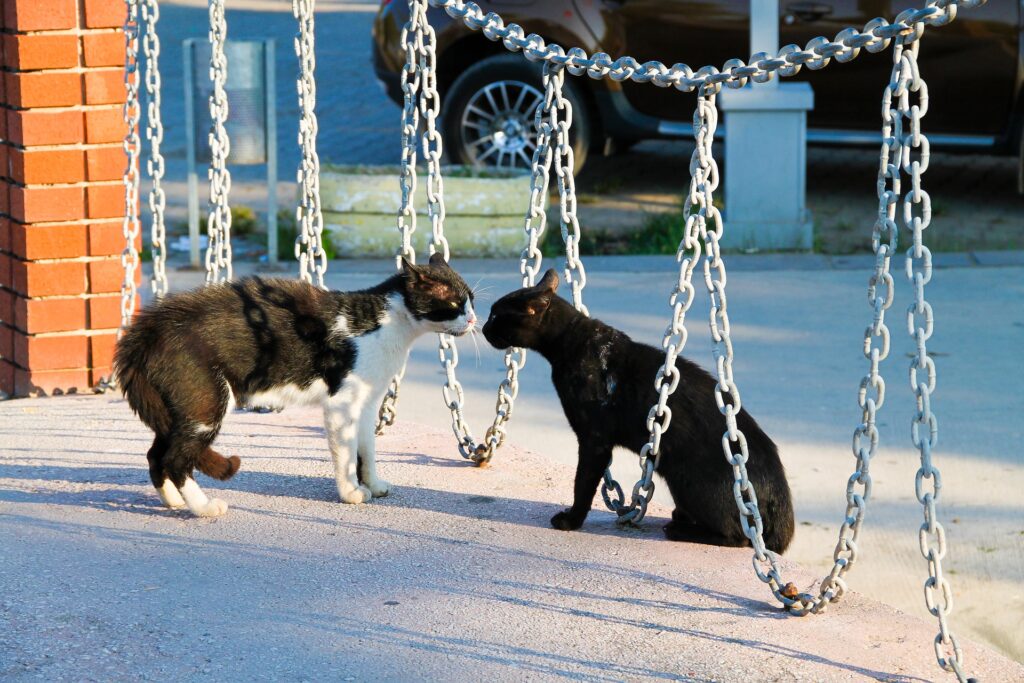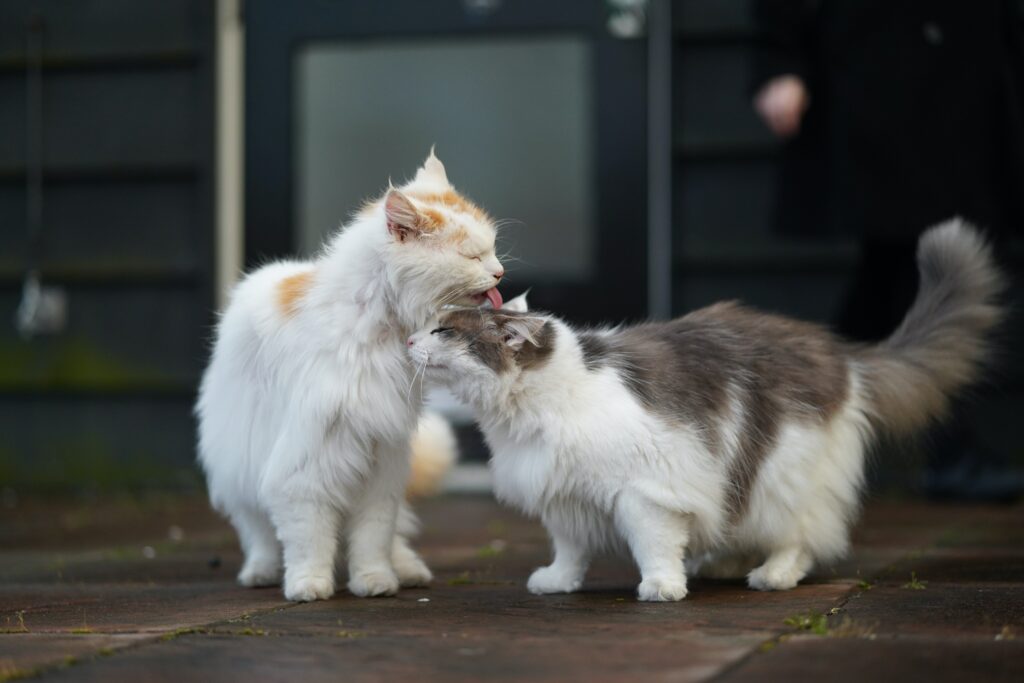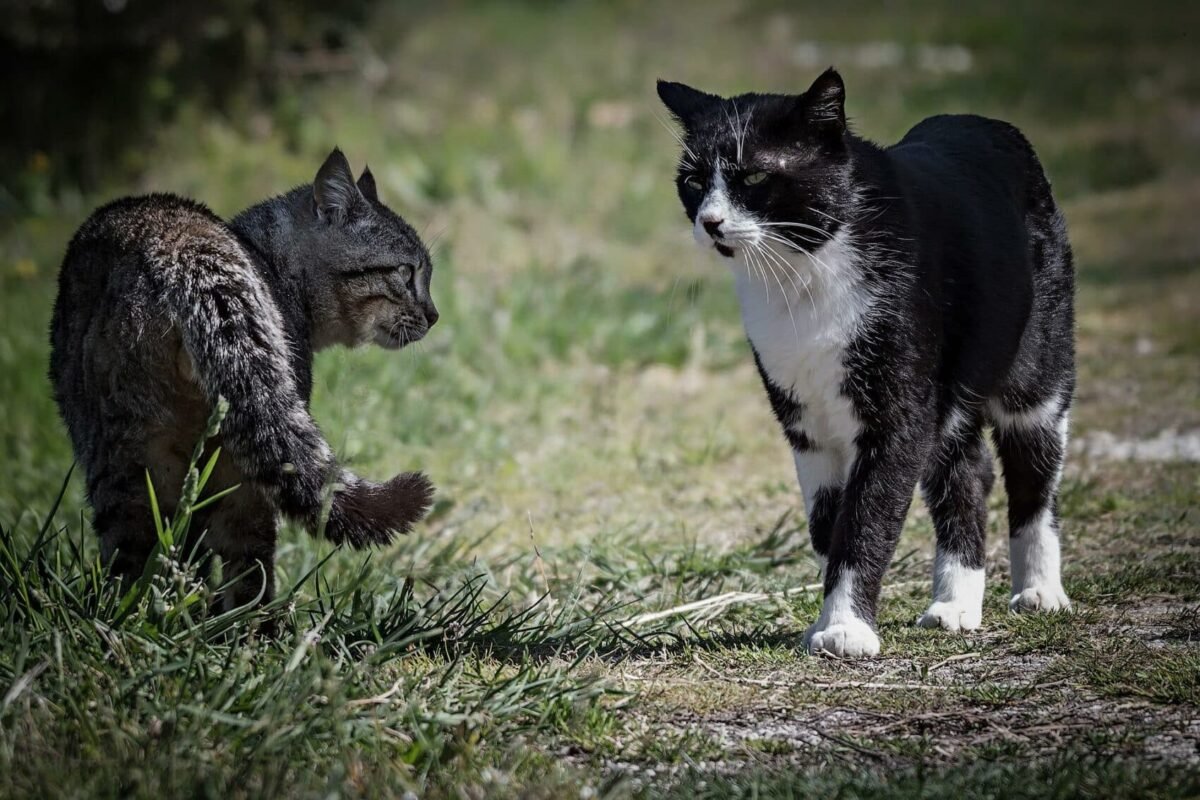We're an affiliate
We hope you love the products we recommend! Just so you know, we may collect a share of sales or other compensation from the links on this page at no additional cost to you. Thank you if you use our links, we really appreciate it!
Introducing your resident cat to a new cat can be a challenging task. As a furparent, you need to know some warning signs when introducing cats.
Cats are very territorial and they sometimes prefer having their solitary space. You might run into some problems when you bring a new kitty to your home without prior preparation.
Your resident cat may not like it when a new cat gets into their territory.

The resident cat may become hostile to the newcomer. They may hiss, growl, and rumble and even show aggression toward each other.
It is possible to see cats physically attacking each other in such a situation and this is dangerous and can be life-threatening.
With proper preparation, you can introduce cats flawlessly and reduce the chances of aggression and hostility.
Introducing cats may take a few days, weeks, and even months. If you do it properly, they will get along without much resistance and within a shorter time.
If You Haven’t Started the Introduction Yet
If you are here, you probably already started the cats’ introduction process. I would advise you to read our ultimate guide on how to introduce cats before you go further. You might need to restart the process if you’re having a lot of trouble.
If you have a dog, don’t worry! You can learn how to introduce your cat to your dog at home with our ultimate guide.
7 Warning Signs When Introducing Cats
You can minimize the cases of intolerance by your feline pets by carefully looking out for warning signs. Your resident cat will be reacting to the new cat, while the newcomer tries to adjust to the new environment.
The following are some of the warning signs when introducing new cats:
1. Staring at each other
Your feline partners will stare at each other immediately after they spot each other. The resident cat may stare at the newcomer because they’re feeling uncomfortable or threatened.

If you notice a prolonged stare, then the cats might be building up aggression which might turn out to be ugly. You can come in and separate the cats to calm them down and prevent any attack.
2. Growling
Cats growl to show their fear, anger, repulsion, and distress when in uncomfortable situations. Both the new cat and the resident or one of the cats may start growling at the first instance of meeting. In most cases, the cat who feels more uncomfortable will growl first.
If your resident cat starts growling on the first meeting, they are just trying to communicate their discomfort of having another feline in the house.
Growling is largely normal and should not cause a major concern. In any case, it shows you that your feline partners are mindful of their peace and would raise an alarm if they’re uncomfortable.
3. Hissing
Growling may not be enough for the cats and they may now move it up a notch. The cats may start hissing at each other when their fear levels rise.

Hissing is a defensive sound that is produced by cats when they feel victimized or antagonized.
If you notice your cats hissing against each other, you need to come in and separate them. Failure to intervene might make the cats escalate their tension.
4. Ears flat or pushed back
Another warning sign to check out when introducing cats is how they move their ears.
Cats will flatten and push their ears back when they feel nervous, threatened, or anxious. They do this because they feel threatened by the new feline.
Cats flatten their ears and move them back to protect them from any external attack. At this point, your cats are fearful that the other cats may pounce on them and start fighting.
5. Dilated pupils
Your cat’s pupils might become dilated during the first encounter. This shows that the furry partners are fearful and defensive. They are keeping a close eye on what might happen next.
6. Puffing out their fur
Your feline partners may puff out their fur at the first instance of meeting. This is a defensive move as the cats are trying to bulge out their bodies to appear big. The cat that feels more insecure will puff out more fur than the dominant cat.
7. Chasing and hiding
In cases where the dominant cat is scaring off another cat, then the less dominant cat will run and hide for their safety.
Common places where cats can find safety include under the bed, sofa, and behind the curtains.
Sometimes the hiding cat may refuse to come back because they’re scared of the stronger cat. If this happens, then you need to separate the cats and look out for the hiding cat to show them some love.
How To Get Cats to Get Along
There is no definite time when cats will all get along. Some cats will be friends within a few days, others weeks, and some will take months.
You can however come into play and help your cats get along faster and more peacefully.
1. Increase your Cats’ Resources
If you have a single cat, then you need to prepare your home to host multiple cats. The preparation will entail providing the cats with adequate resources to live happily and in harmony.
Cats should not compete for any resource. This may build up tension and make them fight in some cases.

Ensure you add an extra cat litter box for your newcomer. Cats are hygienic animals and they may not be willing to share a litter box.
You can get an automatic cat litter box if you have a newcomer kitten to make it more convenient for them.
Cats may similarly not find it easy to share feeding resources. This may make the feline partners hostile to each other while competing for food.
Create another feeding station for your new cat. Feeding points should have cat food bowls, an automatic cat feeder, and cat water fountains.
You need to separate where your newcomer will sleep. They should sleep away from the resident cats’ sleeping area.
Consider getting a tall pet gate to separate the two rooms, where the cats can see each other but they can’t physically reach each other. This can help speed up the introduction phase.

For the start, it is important to have the cats sleep in different cat beds. They can, later on, share their beds when they are used to each other.
Get more interactive cat toys for your feline pets. You should ensure that your furbabies do not clash during their play time because of inadequate cat toys.
2. Allow your resident cat to cool down
Once your feline partners have met and raised their curiosity, you need to allow your resident feline to cool down.

Take them to a separate room and let them cool down from the possible aggression build-up. Do not force your cats to get along with a newcomer immediately. Allow them to become friendly at their own pace.
3. Eating together
If your fur friends do not compete for food, then you can have them take their meals near each other. Have different food bowls for all cats and let them eat in harmony.
Make sure all the cats have a generous food portion to reduce any chances of a conflict.
4. Use a Pheromone Diffuser
A Feliway Diffuser sprays pheromones which helps cats to calm down in stressful situations. These scents also help your cat to respond calmly to changes.
Your newcomer cat will easily adapt to their new home, and the resident cats will easily accept the visitor. You can plug these diffusers in your new cats’ rooms, the living room, and walkways.
5. Reward your cats when they tolerate each other
Have some tasty cat treats and reward your cats when they’re staying calm together. Show them that you are happy when they embrace each other.
6 Signs Cats Are Starting to Get Along
You can know if your feline pets are getting along by looking at how their behavior changes. Cats who once could not stand each other are now embracing each other.
There is no specific time for cats to get along. Some become friends after a few days while others take months.
1. Sharing a room
If you notice your furry partners spending some time together in a single room, then you can be sure that they have started to embrace each other.
The resident cat is now accepting the newcomer as part of the family. There’s no more hiding and chasing.
You can also observe how the cats are behaving in the room. Are they still very alert or do they feel safe together? This will show you the extent to which they have embraced each other.
2. Eating from the same bowl
Friendly cats have no problem eating from the same bowl. You can notice this even when you have given every cat their bowl but they still eat from one bowl while interchanging.

3. They great each other
Your furry partners are now raising their tails and meowing when they meet. This is a sign that they are mindful of each other.

They can go further to rub their heads together and even lick each other for some time. This act is an exchange of love and affection.
4. They groom each other
Friendly cats will groom themselves regularly. A cat will help their partner to clean some areas of the body that are out of reach.

5. Playing together
The tugs and runs are no longer boring. Friendly cats will participate inclusively in their games to get the most excitement. They no longer fight for toys. They can now share some of their toys without much competition.

They further engage in running, jumping, and chasing battles, especially on their scratching posts.
6. They sleep together
After playing together for some time, your feline partners are now tired and sleeping together on the couch. This is to tell you that they can now share the same space without conflict.
If your kitties are showing the above signs, then they have finally accepted each other. The newcomer has now become part of the family and they feel at home.

However, you should not assume that the cats no longer need their solo spaces anymore. Sometimes cats may want their alone time in a solitary place to rest and calm down.
You should therefore maintain every cat’s room and hiding area. Let them have all the resources available for them whenever needed.
What To Do If Cats Get Aggressive
Sometimes cats can become aggressive when introduced. At such a point, you need to intervene and prevent a possible physical attack. This is especially common for aggressive cats and those that are too territorial.

To prevent your cats from fighting, you need to introduce them in the presence of a second person. Both of you should stay alert and watch out if there is a possibility of an attack in the first instance.
If you notice any signs of fighting, you need to immediately back off and take the furry friends to their respective rooms. This is a warning sign that the cats might take much longer to get along.
You can then swap your cats’ scents, which plays a role in making the host cat accept others in their territory.
Get some accessories e.g., towels with your resident’s cat scent, and take them to the new cat’s room. Let the newcomer get the resident cat’s scent.
Do the same for your resident cat, let him get the scent of the newcomer. You can also switch the cat’s bedding.
Let them interact with each other’s scent and smell. As you do this, continue making use of the pheromone spray.
Once you have done this for a few days, you can now reintroduce the cats. This time a bit more careful to prevent any aggression build-up.
Have more than one person do this for you to contain any possible physical attack by the fur babies.
I have written an article on how to deal with an aggressive cat. You can check out that article to find more tips on how to cool down your cat when aggression builds up.
What Not to Do When Introducing Cats
Now that we have looked at some of the things you can do to introduce cats, what about the contrary? There are some things that you should try to avoid whenever you want your resident cat to welcome his newcomer furbaby.
1. Introducing your cats too quickly
Once you have arrived home with the newcomer, do not rush to introduce them yet. Let the new cat stay in their house for some time, even days.
Allow them to get familiar with the new house. If you introduce them quickly, then the new cat might feel intimidated. They’re trying to catch up with a new environment plus a new furry friend.
2. Leaving your cats unsupervised
Your cats should not be in close proximity while unsupervised. Every time you want to bring the cats in close contact, ensure you are there to watch over them. You can then be able to monitor their interactions closely.

The cats will also feel safer in your presence. They would come down and have a reduced chance of building up tension.
3. Forcing your cats to get along
Be patient and allow your furry friends to get along with time. Do not force any of them to immediately accept friendship.
You might cause more damage than good when you do this. Make the process as natural as possible. If your furry partners will naturally get along, then they will maintain the bond for long.
4. Shouting at them
When you shout or punish your furry friend for not accepting a visitor, then he might become aggressive. Shouting at your cats will only increase their stress levels and make them more anxious.
To Conclude
If you observe any warning signs when introducing cats, it is best to separate them immediately. Do not force your resident cat to immediately accept the new furry friend.
Let them take their time to learn and embrace each other at their own pace.
Thank you for reading through this article. If you have any questions, please leave a comment below and I will get back to you.
Laura is the founder of Furs'n'Paws. She is a also a pet writer and expert with more than 20 years of experience of working with dogs and cats. She developed a very strong love for animals at a young age. Her passion led her to establish a thriving pet sitting and dog walking business in Dubai. As an expert in pet training, behavior, and nutrition, Laura is committed to helping pet owners and pet lovers by offering high-quality information on a wide range of topics.



39 Responses
Hi, I ready your article and understand that this may be a lengthy process but was just looking for some insight. i have 2 sister cats (1.5yrs) and recently found a feral male kitten (now 5 months) it’s been three months and one of the cats has accepted him, but my second cat isn’t coming around. i’ve done a very slow introduction ; scent swapping, separated rooms, feeding on opposite side of door, introducing one cat at a time & keeping the two older cats apart when i bring the kitten around. the second cat hisses, growls, and seems to be aggressively swatting at the kittens paw when he sticks it under the door. i’ve been trying supervised short visits, and my cat just stares the kitten down and will sort of charge at him. i stay in between the two of them during all visits to be sure that my kitten is safe. my kitten is unphased by the cat and he is so sweet, but it’s been 3 1/2 months and i’m afraid she’s not warming up to him. the older cat gets aggressive with her sister after seeing the kitten, gets aggressive with my dog, and has even gotten aggressive with me.. the other animals all get along expect my one cat. i really don’t want to rehome any of them but i’m afraid that she’s the problem. i will continue to try slow introductions but any insight is helpful.
Hi Jessica, considering neutering your kitten when he is old enough could potentially help, but it’s not a guaranteed solution. Since your second cat is still reacting aggressively, it might be beneficial to take a step back in the introduction process, return to scent swapping and separate rooms, allowing your second cat more time to acclimate to the new scent and presence of the kitten.
It’s important to keep in mind that some cats may require more time to adjust or get used to each other, and not all cats will necessarily get along. In cases where conflicts persist, managing their environments to prevent confrontations and ensuring each cat has their own space, toys, and attention can be essential for maintaining a peaceful and safe household.
Additionally, seeking guidance from a veterinarian or a professional cat behaviorist for personalized advice is crucial if the situation doesn’t improve over time. They can assess the specific dynamics between your cats and provide expert recommendations for managing the situation.
my boyfriend and i recently adopted a new cat (female, about 5 years old). we have a cat already (also female and 5, almost 6, years old), and we’ve been doing the scent swapping and door feeding for about a week. our resident cat seems fine with the new one’s scent, we just recently did a room swap for about an hour and she even pooped in her litter box, but when she sees our new cat she hisses and growls. is there any advice on how to reduce that? i know it’s normal but i want them to spend more time together and we’re afraid she’ll attack our new cat. we always try to keep our new cat in her separate room (the guest room), but she’s so desperate to roam around she always tries to escape when we open the door. and it’s not like we don’t spend enough time with her, my boyfriend has been sleeping in there with her and i’m sleeping in our bed in case our resident cat wants one of us. this is part of why i ask about any advice on keeping my resident cat cordial, because it’s exhausting having to chase my new cat around if she escapes and i don’t want things to get out of hand if for some reason she gets out and i can’t catch her in time.
Hi Grace, it seems like your cat still needs time, the introduction process needs patience and things can’t be rushed. As long as you see aggression you need to continue with the scent swapping, exchanging territories, supervised short meetings & positive reinforcement… Unfortunately this can’t be rushed, and if you try to rush it things don’t go well. Good luck!
Hello! About 2 months ago I adopted a 9 week old male kitten. I have a 3.5 year old male cat who is pretty shy in general. For the first 3 weeks, I did introductions very slowly. Started the kitten in a separate room and only did scent swapping (my older cat hissed at a toy that smelled like the kitten, so it’s been a slow process to say the least)
After about 3 weeks, I decided to let the cats see eachother face to face, my older cat was cautious with some hissing and growling each interaction, and would eventually go hide.
Now almost 2 months in, my older cat has seemed to “accept” the kitten. No more growling or hissing, doesn’t hide as much, and sometimes will swat if kitten is too rough, but mostly will just lay on the floor nearby and observe the kitten.
The more supervised interactions I have with the two, I’ve started to notice that my kitten will always resort to an aggressive play behavior with my cat. He pounces, hunts, and bites my cat. When the kitten is just with me, he’s still playful…but also cuddly and calm.
It seems that everytime he comes in contact with my older cat now, all he wants to do is aggressively play with him, which my older cat isn’t super fond of. I worry that this could permanently damage any type of relationship that could happen, due to the kitten stressing my cat out each time they are together.
My older cat seems to not be super aggressive in asserting dominance with the kitten, so I’m unsure how to help make the kitten back down when they are together. I’ve tried to distract him with toys, but he’s much more interested in pouncing on my adult cat rather than a play toy.
Any advice or confirmation we are making progress with the intro would be great!
Hello, I can see that you definitely made a lot of progress which is great. Here are a few points to keep in mind that could further assist you in this process:
– You need to keep in mind that some cats may take longer to adjust than others. 3 weeks might seem like a long time to you, but they probably still need additional time to fully warm up to each other.
– Remember that you have big age gap here; a 9 week old kitten is very active and playful while a 3.5 years old male is more mature and less energetic, it is very normal to observe a difference in behavior and for the kitten to jump around your cat and play with him.
– Make sure to give your kitten plenty of playtime to let his energy out before you allow him to interact or play with your cat.
– Keep supervising them, as soon as you observe aggressive play from your kitten separate them immediately and put him in a room to allow him to calm down for at least 30 minutes
– Reward positive behavior and normal play with treats
– Don’t rush things and keep on doing the gradual exposure
– Try some pheromone diffusers as they might help with your kitten energy
I hope these tips are helpful, please keep me posted on how things go! Best of luck.
We found a kitten a few months ago who had no mother and no siblings in sight for two days before she was picked up. We wanted another cat but we’re waiting until we moved, since we were in the process of buying a house. Now that we’re in the house, our resident kitten (4 months) is all settled in, and we got another kitten also 4 months. Both are females, and the new kitten is spayed but ours is not yet. We kept them separated for a day but someone told us kittens normally get along better than cats, so we introduced them last night. Our resident kitten was hissing at first, but she could be redirected. The new kitten came from a colony and she meows nonstop when we’re not in there and she meows even more if she hears the resident kitten. She was so excited to see our kitten, but the resident one starred swatting at her and getting in her face, so we separated them again. We both work full time, so I don’t want the new kitten to be stuck in that room all the time and I’m afraid if it takes a few weeks it will be harder because they’ll both be more like adult cats than kittens. Any advice?
Hi Taylor, unfortunately there are no shortcuts when introducing cats or kittens specially now that you’ve seen there’s aggression between them when you gave it a try. The introduction process has to be done properly and slowly until they get used to each other. Also spaying the other kitten might help the process.
In the process of introducing new cat 1.5yo tiny Un spayed female to 3 yr old, neutered 7 months ago make (both shelters, he’s been here about 2.5 months, her about 3 wks. Started in separate rooms, swapping scents, letting him come in and investigate her room every once in awhile (with her elsewhere)
He seems to have no problem w her smell. Put one of her blankets out for him and he sleeps on it. He will immediately use her litter box if let in her room.
With 2 exceptions he’s shown nothing but interest: laying in front of the door, whining, trying to see her.
I know he sits out there quite a lot, “talking” to her.
We have progressed to the cardboard barrier w window stage- first time didn’t cover it and he reached his leg through and something went wrong, someone yowled. Mostly he’s just cute-touching the clear tape barrier w his paw, rolling on his back w paws in the air.
Sometimes she seems interested, largely not.
Usually I was on her side of the barrier. The first time I was on his side he seemed fine, then lunged at the barrier. Aggressively, not playful. Since then he’s seemed fine.
Put them both in very large cat houses- not carriers, they are soft sided things w mesh sides. Started far apart, they didn’t seem to care, eventually got within 6 inches and they were cute, doing the high pitched chortling type sound, ears forward.
Are we ready for them to meet? Do you think they will be ok? Are these positive signs? Or just NOT negative ones?
He is twice her size (she wasn’t eating in the shelter and was pulling out all her hair. She’s really pitiful looking.)
So I’m worried about it.
Any suggestions?
Hi Annie, there’s definitely some progress in the introduction process here however there are still some signs of aggression which means you still need to take this slow.
Continue with the gradual introduction by allowing them to interact through the cardboard, you can start increasing the time while doing this but of course with supervising them and making sure they remain calm.
Reward all positive behaviors, if they stay calm without any issues give them treats and lots of positive reinforcements such as praise and affection.
Once they show positive behavior through these separate meetups you can start with short-term face to face meetings. These meetings should be supervised closely and in a safe space allowing the cats to have some hiding spaces when needed. Keep them as short as possible in the beginning and as soon as you notice any aggression remove them immediately.
This process can get a bit frustrating as it can take a lot of time, it all depends on the cats. So do not rush it and be very patient as one mistake can take you back to the start. Good luck!
Hello, i have a fixed 7mo Burmese make (Moose) and we just rescued a 5mo fixed female 2 days ago (mollie). Moose always seemed lonely and wanting to play with our dog who is so afraid of him. So we got him mollie thinking he would love her. He hates her. All of the sudden he has turned into this hissing ferrel cat. Its bizarre. They both have their own rooms, but we didn’t know about the steps system and introduced them right away. Molly was such a sweetheart and she is ready to play with moose and be his Besty. At this point can I reset an how do I go about doing this?
Hi Cory, Yes you can. Please follow the steps in this article. Introducing cats is a lengthy process and needs lots of patience.
Hi, you’re article has given me some great reassurance! I have a 3 year old cat that has lived with an 18 year old cat before. My 18 cat passed away last year and my 3 year old cat has been alone since. I recently adopted a 8 week old kitten, my 3 year old cat will sleep and eat and play in the same room as my kitten but will attack if he comes up close to him. It’s only been 3 days but my 3 year old cat won’t let me stoke him and no longer follows me from room to room, his behaviour has changed and it’s extremely upsetting for me as we were so close. Will my 3 year old cat accept my kitten and start acting exactly like himself again?
Hi Millie, I suggest you start over and follow the steps in the following guide. It’s very important to be patient with the introduction phase, this can take anywhere between a few weeks to a few months. Patience is key here. Good luck! 🙂
I know this takes time and patience to introduce a new cat into the house, my concern is the new cat being stuck in a room and not having the freedom if it takes awhile.
What is your experience or opinion on introducing a a spayed female kitten (4-5 mths) to a neutered male who is about 3 1/2? We thought we were getting a boy kitten to be his friend but long story it ended up being a girl haha. Taking her home after the holidays, and I have lots of toys for her plus food bowls & things for her that were not used by the current cat! I’ve been doing lots of research on introduction & honestly it’s kind of got me stressed out. Especially now that we are bringing back a female vs male!
Hi Chelsea, in terms of your kitten being stuck in a room, it is very important to keep her entertained with toys and playtime. This way she wouldn’t feel stuck in 1 room or get bored! Also during the introduction process it is advised to let the cats swap rooms so she won’t be in one room all the time.
As for the introduction, don’t stress about it too much as long as you do all the steps the right way things should be fine! I would advise you to check out my other article about this https://fursnpaws.com/how-to-introduce-cats it is more detailed and should give you clarity on how to do things step by step. 🙂
Hi! I switch their rooms everyday, so that they can get used to each others scent. It has taken me a year to introduce my cat, the key really is patience ❤️ and I have two females, the resident cat is 12 and she has never known any other animals, so it took a little for her but not she is loving and grooming my 2 year old cat.
Introducing cats can be a very lengthy and slow process and as you said, the key is patience. I’m happy that it worked well for you!
Omg…a year?….I’ve adopted a second cat yesterday and the resident cat hisses eyerytime she smells the newcomers scent and while exploring the newcomers base camp. The resodent cat is 10 month old female and the newcomer is (supposedly) an 8 mo male, which seems a bit huge for 8 months.. They’re both fixed.. I hope I won’t have to return the newcomer 🙁 he is such a sweet kittie❤️ but the shelter gave us 2 weeks to let them know whether we are keeping him (if it’s a match) or returning him….
We recently got a new cat that I rescued from my sister in laws. She was always stuck in a room and often no one was home. There was another cat in the house and no issue there.
There are 3 resident cats in my home. All fixed….a 3 year old male, Orion, and 10 month old brother Jasper and sister Luna. The new female cat, Lucy, is just over 2. We also have a small senior chihuahua named Shorty. When we brought Lucy home she was not fixed. She would hide all the time and there was really no aggression between the cats at all besides maybe a small hiss in passing. Lucy is now fixed and has become super sweet to people but is VERY aggressive with the other cats. She is fine with Shorty. Lucy will chase the other cats while high pitch growling. She sounds like a banshee. This is always unprovoked, whom ever she decides to go after will just be laying there. When she does this I catch her as soon as I can and put her by herself in the spare room. I’m having a hard time here because it’s not a constant thing, as they have all been in a room together and there was no issue. I did somewhat notice that it’s been worse if I’m walking around. She will go right in front of me like she is guarding me or something. The others have not gone after Lucy and they haven’t gone after me.
Hello, I believe its worth it to do the introduction process from scratch here and separate Lucy from the others for a while while introducing her again step by step. Are they all usually sharing the same food bowl and litter box? Maybe getting Lucy her own stuff when separating her would help too. Hope this helps!
Hi! Loved your article. My 2 yr old yowls all night if he’s separated from our new “baby”-she’s 2 months old. Generally he’s ok with her, they nap together, he’s not bothered about sharing food, he sometimes licks her. But other times he can be very dominant, to the point his fur stands on end and she squeaks. They were separated for the first week, and now they are together. Otherwise my cat won’t shut up. Will this dominance/aggressiveness pass? I worry for her.
Hello Alexandra, really glad you like my article 🙂
In your case, I would advise you to monitor your cat and see whats making him dominant or territorial. Perhaps you need to start separating their food, bed, litter box… it depends on whats triggering his behavior. Once you find out the trigger and you make a change the issue should be resolved.
Hi there! So I have a pair of bonded kitties who have been inseparable since birth (littermates!) who have recently started fighting. It’s breaking my heart. I am not sure what caused it, but I have had them separated for about 2 weeks now. I have slowly started introducing them back to each other by feeding them on opposite side of a closed door/now a screen door. They aren’t hissing or growling when they see each other anymore, and seem to be touching noses through the screen mesh. Is it time to let them be together again? I don’t want to ruin all our progress.
Hi Ella, you can start letting them out together however for short periods and under your supervision, as soon as you see any sign of aggression separate them immediately. Same for good behavior, if you let them out together for 10mins and they were well behaved reward them with treats.
I would say start with 10 mins for a few times, and if you notice good behavior from both of them on the long run start increasing the time bit by bit, and don’t rush it 🙂
Hi, I am andrea and I am a hospice nurse and I had a patient who had a cat that she loved very much and I ended up becoming very close to the family and I promised my patient that I would take her cat Lila who is 15 years old in to my home once she passed Recently she has passed and I brought Lila home where I have a two year old cat who is a rescue and a six month old kitten who is also a rescue and it is very important for me for them to get along, but I’ve noticed that they are very territorial of me. I live in a smaller space and I have a camera where I can watch everything they’re doing and as long as I am not in the room and Lila is in the carrier, they don’t seem to mind each other too much, but once I come into the room, they seem to become more aggressive, hiss and growl at each other. I’ve looked at many YouTube videos. I’ve read a lot of articles to try to understand how to introduce them, now my two-year-old cat and my six month old cat it didn’t take long for them to get along. I’m not sure what to do. I’m afraid to let them out all together. Lila the 15-year-old cat. She has kind of a hip problem and can’t really walk all that well and I’m afraid that my 2 year old cat that might hurt her. Saint my six month old cat is a little more accepting of her, but Lila doesn’t want him near her. I want what’s best for all three of them and I will want nothing more than for them to get along, so I can keep your promise and I can love all of them.
Hi Andrea, I totally understand the struggle. My advice to you is to not rush the process, keep them separated for as long as they need, let them eat in front of each other while there’s still a separation, reward them with a treat if they finish eating without growling at each other or for any other good behavior.
Let them switch places, for example let Lila out in the house when you get home for 30 minutes and your 2-year old cat in Lila’s carrier so that they get used to each other’s scent, do not let them interact at any point until you notice less aggression and more acceptance. This may take longer than the usual because you have 2 adult cats, which usually is harder than introducing a kitten to an adult cat.
I recently rescued a 9 month old female from a shelter. My 8 year male is an inside/outside cat. Now he won’t come in unless he’s hungry or wants to sleep late at night. I feel this is slowing down the process of both cats getting to know each other. Neither seem happy with each other. Hissing, growling behind closed inside door. They are in separate rooms and I’m trying the steps. I don’t want him to feel kicked out of his own home.
Hi Karen, I hope the introduction process works out. Try to keep him in as much as possible until they get along and then he can get back to his routine. Good luck!
Can we start over if we totally messed up and didn’t realize there were steps to introducing a new kitten? Ruby is about 4 months, fixed kitten and we introduced Dexter, about a 3 month old, fixed male. Ruby has been with us for about a month and a half and we thought she would love a friend, so we got Dexter and she HATES him. So is it possible to start the introduction process over?
Hi Angie, yes definitely you can start the introduction process over. It should be faster and easier now since some familiarity has been already established! However never rush the process and follow the instructions step by step! 🙂
I have a mama cat that has been in my spare room with her babies, and babies are now fully weaned (they’re about 8 weeks old now). I have slowly been introducing the kittens to my 2 adult cats, and things are going really well. Mama still freaks out when she sees my 2 though. She lunges for them with growling and hissing. She wants out of the spare room really bad, so she is becoming quite an escape artist. I have a baby gate up (slows her down a bit) and I have to put a screen across my hall so she doesn’t see my 2 when I go into the spare room. I have never had an issue introducing cats/kittens to my cats (I foster), so I’m kind of stumped as to what to do. This is mama’s first litter and she was about 9-10 months old herself when she had babies, so I’m not sure if that has anything to do with it. Any advise would be appreciated!
Hi Melvin, are you keeping the kittens with their mom still or did you totally separate them from her? If they are staying with her still she could be protective over them hence the difficulty to introduce her to your cats, so try to separate her kittens from her. Another factor that you could consider is first spaying her before trying to introduce her to your cats then do the introduction process again step by step. Hope this helps 🙂
Many thanks for this valuable and comprehensive post. About Warning Signs When Introducing Cats. This is really a very important post for me. Because I have two cats. I have seen them become very aggressive when other cats come around. I was expecting another baby. Your post will be of great help to me. Keep posting like this.
Glad you found my guide helpful! Indeed cats are very territorial and don’t like new cats crossing their territory. Introducing new cats is a slow and long process. Congrats for your new baby!
Wow! this was an interesting read. Even cats safeguard what they think is theirs. I guess they share some similarities with human beings. I have observed cats staring at each other, making loud sounds and even fighting when introduced to each other, but I didn’t know what to do to make the introduction easier for them. You article has definitely educated me.
I’m happy you found my article useful. You said it right, cats are very territorial and don’t like it when new cats are brought in to their environment. Time and patience are key here, you should always take your time when brining in new cats. Following the process I described will definitely put you on the right track.
We adopted 2 kittens from the same litter just over a year ago, but one recently sadly died. Our remaining cat’s behaviour changed and she stopped being a young excitable cat as she had always played with her sister and became quite lethargic. We got a 12 week old kitten 4 days ago and have kept her in her own room with a glass door so that our older cat can see her. We had a really great introduction with no hissing and some sniffing but then the kitten got excitable and ran at our existing cat to play with her and she than hissed and biffed her. What would you recommend to do next? Do we try introducing again or go back a step and keep swapping scents?
Hi Flo, I would try to introduce them again, check this guide for a more detailed approach